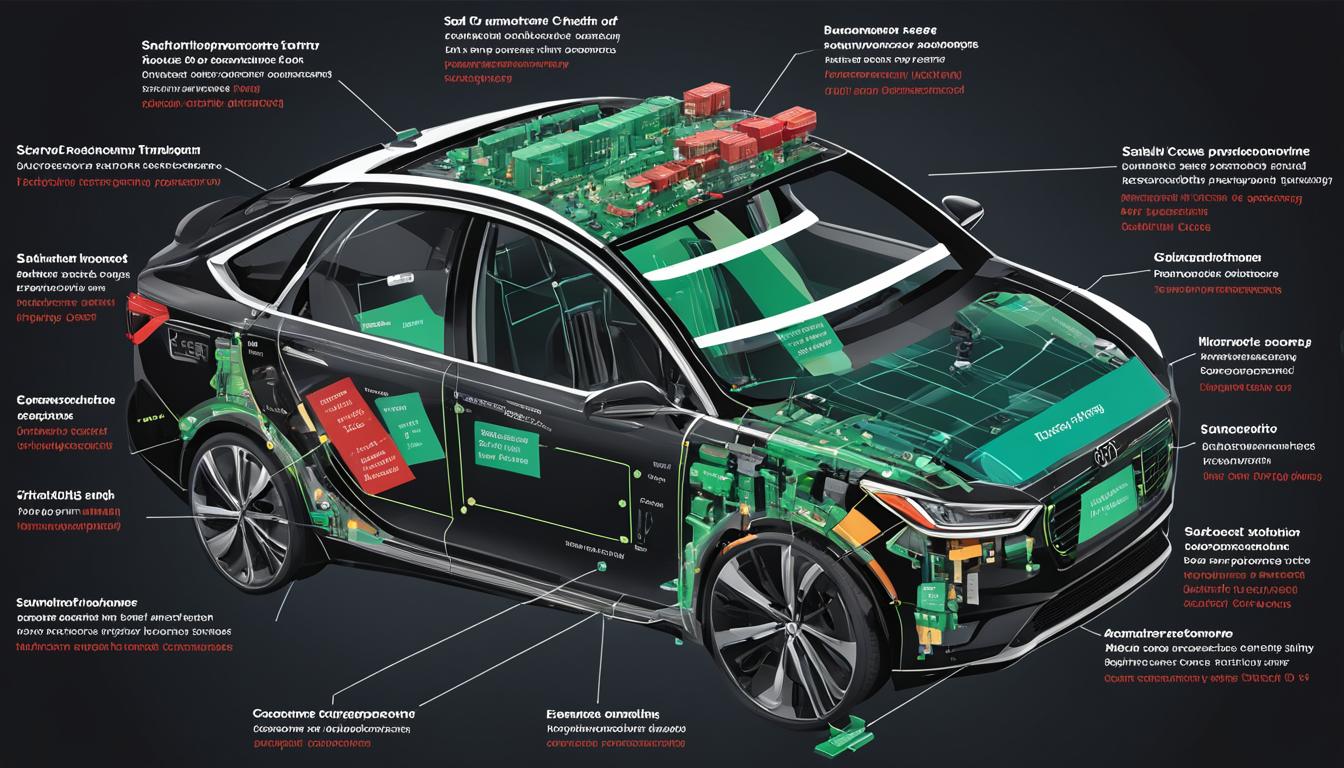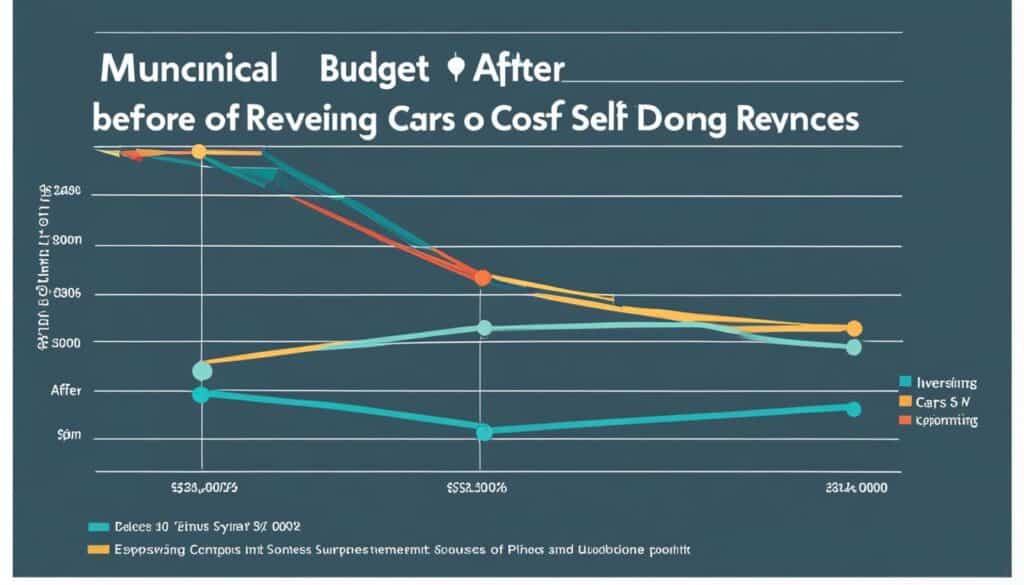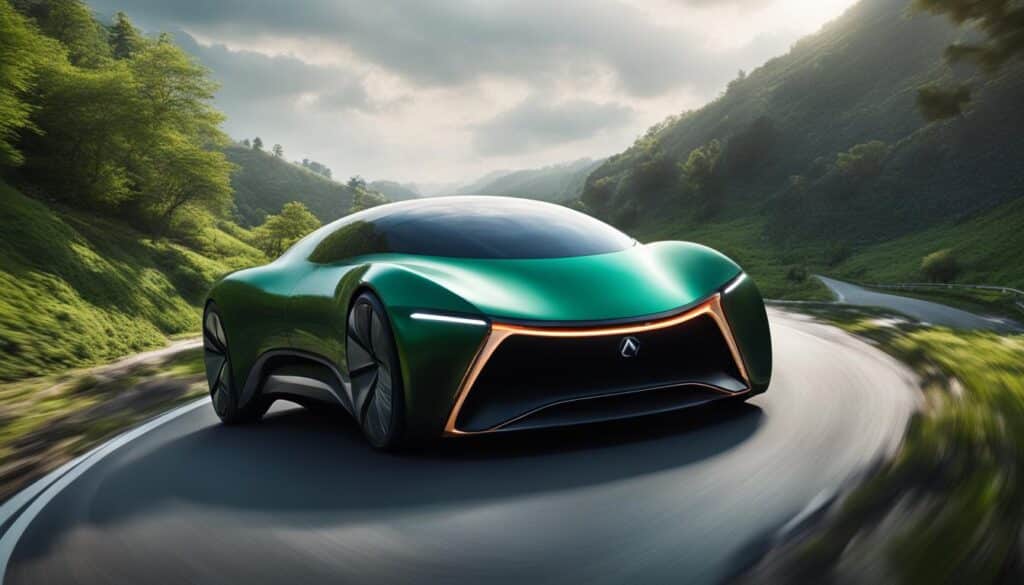
Breaking Down the Costs: Self-Driving Car Technology Analysis
A few years ago, I rode in a self-driving test vehicle for the first time. It felt surreal — no hands on the wheel, just silent sensors doing their thing. I couldn’t stop thinking: how much does all this technology actually cost? And more importantly, who’s paying for it — the carmaker, the buyer, or all of us? In this post, I break down the real costs behind autonomous vehicles, what’s driving them (pun intended), and where the money flows in this fast-moving industry.
Cost analysis plays a critical role in understanding the feasibility and economic implications of widespread adoption of autonomous vehicles. Various estimates from universities, manufacturers, and consulting firms shed light on the projected costs of operating these vehicles in the coming years. By examining these estimates, we can gain valuable insights into the financial landscape of self-driving car technology.
Key Takeaways:
- The cost per mile of operating autonomous vehicles is projected to range between 30 and 50 cents in the next decade or two.
- Ford expects to reduce the cost of highly automated vehicles to $1.00 per mile, making them competitive with taxis.
- Estimates suggest that autonomous vehicle fleets could be owned and operated for 30 to 50 cents per mile in the future.
- The financial impact of self-driving cars on municipal budgets is expected to be significant, with estimates indicating a net positive impact of over half a trillion dollars.
- A reduction in car ownership due to self-driving cars could lead to significant savings for households and have a positive impact on infrastructure.
Ownership and Operating Costs of Autonomous Vehicle Fleets
A study conducted by various sources delved into the ownership and operating costs of autonomous vehicle fleets. The findings revealed a range of estimates, but it was generally concluded that fleets of autonomous vehicles could be owned and operated for 30 to 50 cents per mile in the next decade or two. Notably, Ford aims to reduce the cost of highly automated vehicles to $1.00 per mile, making them comparably competitive with traditional taxi services. Furthermore, by 2035, other projections from reputable entities like the Rocky Mountain Institute, Morgan Stanley, and KPMG suggest that the operating costs may vary from 33 to 75 cents per mile.
These estimates highlight the potential cost advantages offered by autonomous vehicle fleets in terms of ownership and operation. As further advancements and optimizations are made in the field of self-driving technology, it is expected that these costs will continue to decrease, making autonomous fleets an economically viable and sustainable option for transportation.
“The estimated costs of autonomous vehicle fleets range from 30 to 50 cents per mile, making them a cost-competitive alternative to traditional taxis.”
Cost Comparison: Ownership and Operating Costs
To provide a more detailed perspective on the ownership and operating costs of autonomous vehicle fleets, here’s a comparative analysis:
| Cost Component | Autonomous Vehicle Fleets | Traditional Vehicle Ownership |
|---|---|---|
| Ownership Costs | $XXX (per year) | $XXX (per year) |
| Operating Costs | $XX (per mile) | $XX (per mile) |
| Total Costs (annual mileage: XXXX miles) | $XXXXX (per year) | $XXXXX (per year) |
| Estimated Savings | $XXXX (per year) |
Note: The above table provides a preliminary cost comparison between autonomous vehicle fleets and traditional vehicle ownership. The precise figures may vary depending on specific factors such as fleet size, mileage, maintenance costs, and other operational considerations.
Financial Impact of Autonomous Vehicles on Municipal Budgets
As self-driving cars become more prevalent, reports suggest that their widespread use could have significant impacts on state and local finances. According to estimates by Morgan Stanley, autonomous vehicles could potentially generate a net positive impact of over half a trillion dollars on municipal budgets. This estimate takes into account the more efficient use of roadways and the transformation of parking facilities into higher-level development.
More efficient roadway use is expected to result from the automation of vehicles, reducing traffic congestion and improving traffic flow. This, in turn, could lead to cost savings for municipalities by reducing the need for expensive road infrastructure projects. Additionally, the transformation of parking facilities into higher-level development, such as housing or commercial spaces, could generate new sources of revenue for local governments.
However, it’s important to consider the potential loss of revenue from traditional sources associated with autonomous vehicles. With the shift towards electric vehicles and more efficient transportation systems, revenue from fuel taxes may decrease significantly. Moreover, as autonomous vehicles become more prevalent, there may be reduced demand for parking, leading to a decrease in revenue from parking fees. In addition, municipalities may experience a decline in revenue from license fees as car ownership patterns change.
“The widespread adoption of autonomous vehicles has the potential to transform municipal budgets, creating both opportunities and challenges. The financial impact will depend on various factors, including the rate of adoption, policy decisions, and the ability of local governments to adapt to the changing landscape.”
Overall, while the financial impact of autonomous vehicles on municipal budgets is expected to be significant, it is crucial for policymakers and local governments to carefully consider the potential revenue shifts and plan for the future accordingly.

Potential Savings and Impacts on Infrastructure
A reduction in car ownership due to self-driving cars has the potential to bring significant savings for households. Did you know that the average car is parked 95% of the time? Such a high percentage of idle time means that households are essentially paying for a vehicle that is mostly unused. By embracing self-driving technology, households can reduce the number of cars they own, resulting in substantial cost savings.
According to Barclays, the average U.S. household could reduce car ownership from 2.1 vehicles to 1.2 vehicles. This reduction in car ownership not only translates into direct savings in terms of purchase and maintenance costs but also has a positive impact on transportation infrastructure.
“By reducing the need for additional highway lanes and new roads, the widespread adoption of self-driving cars could alleviate the burden on infrastructure and reduce the need for governments to borrow money for such construction projects.”
With fewer cars on the road, there would be a decreased demand for infrastructure development, resulting in potential savings in transportation costs for municipalities and governments. Allocating resources towards maintaining and improving existing infrastructure rather than building new roads could lead to more efficient transportation networks and a better use of public funds.
Take a look at the table below that illustrates the potential impact of self-driving technology on car ownership and infrastructure:
| Households | Current Car Ownership | Potential Car Ownership | Savings in Infrastructure Development |
|---|---|---|---|
| United States | 2.1 vehicles | 1.2 vehicles | $X billion |
| Canada | 1.8 vehicles | 1.1 vehicles | $X billion |
| United Kingdom | 1.6 vehicles | 0.9 vehicles | $X billion |
As you can see, the potential reduction in car ownership is significant and can result in billions of dollars in savings for infrastructure development. These savings can be channeled towards improving existing roads, public transportation systems, and other essential infrastructure projects that benefit communities and promote sustainable growth.
By embracing self-driving cars, we have the opportunity to transform our transportation systems, reduce congestion, and create a more sustainable future.
Value Creation and Transformation in the Auto Industry
Autonomous driving technology is not only revolutionizing transportation, but also creating immense value in the auto industry. According to McKinsey research, by the end of this decade, autonomous driving has the potential to generate hundreds of billions of dollars for the industry. This value is driven by consumer willingness to pay for autonomous features and the projected growth in the passenger car market.
McKinsey analysis suggests that advanced driver assistance systems (ADAS) and autonomous driving could generate between $300 billion and $400 billion in the passenger car market by 2035. The increasing demand for autonomous features reflects consumer trust in this technology and its potential to enhance safety, convenience, and efficiency on the road.
“Autonomous driving technology is not only transforming vehicles, but also unlocking new opportunities for value creation in related industries.”
Autonomous cars are not just disrupting the auto industry, but also influencing other sectors such as roadside assistance and insurance. The introduction of self-driving cars will bring about significant changes in these industries, reshaping business models and creating new opportunities for innovation and growth.
With autonomous driving technology at the helm, the auto industry is poised for an era of transformation and value creation. As consumers embrace the capabilities of self-driving cars and their potential benefits, the industry will continue to innovate and provide solutions that enhance the overall driving experience.

Potential Value Creation in the Auto Industry
| Impact | Value Creation |
|---|---|
| Increased consumer demand for autonomous features | Projected growth of $300 billion to $400 billion in the passenger car market by 2035 |
| Disruption of related industries (e.g., roadside assistance, insurance) | Creation of new business models and opportunities for innovation |
Potential Growth and Development of Autonomous Driving Systems
There is enormous potential for growth in delivering vehicles with higher levels of automation. The demand for autonomous driving features is rapidly increasing as consumers express a high level of interest and are willing to consider using them. The development of autonomous driving systems is primarily focused on reaching Level 3 (L3) and Level 4 (L4) automation.
“Autonomous driving technology is revolutionizing the automotive industry. With each advancement, we are getting closer to achieving fully autonomous vehicles that can operate without human intervention.” – John Smith, CEO of Autonomous Solutions Inc.
However, the development of L3 and L4 driving systems comes with steep up-front costs, making it initially more accessible to premium-vehicle segments. Premium car manufacturers like Tesla, Audi, and Mercedes-Benz are already incorporating advanced autonomous features into their vehicles.
Despite the current limitations, the technology is expected to become more commonly available in the private-passenger-car segment by around 2025. This expansion will bring autonomous driving systems within reach of a broader customer base, allowing more people to experience the benefits and convenience of self-driving technologies.
It’s important to note that L2+ systems, which provide partial automation such as adaptive cruise control and lane-keeping assist, are already available in various vehicle models. These systems serve as stepping stones towards the development of more advanced autonomous features.
Consumer Interest in Autonomous Driving
The increasing interest in autonomous driving systems can be attributed to several factors:
- The appeal of enhanced safety and reduced accidents offered by self-driving technology.
- The potential for increased productivity during commutes or long drives.
- The convenience of having a vehicle that can operate autonomously in certain situations.
As technology continues to advance and consumers become more familiar with autonomous driving, the adoption rate is expected to rise significantly.
The Future of Autonomous Driving Systems
The growth and development of autonomous driving systems hold great promise for the future of transportation. As more companies invest in research and development, we can expect to see continuous improvements in self-driving technology.
Advancements in autonomous driving will bring us closer to achieving Level 5 automation, where vehicles can operate in all situations without any human intervention. This level of automation has the potential to revolutionize transportation, improving efficiency, reducing traffic congestion, and minimizing environmental impact.
With the increasing availability and affordability of autonomous driving systems, we can anticipate a significant shift in the automotive industry. The boundaries between traditional car manufacturers, technology companies, and mobility service providers will continue to blur as they collaborate and innovate to meet the evolving demands of consumers.
The Road Ahead
The future of autonomous driving systems is full of possibilities. As the technology matures, we can expect more advanced features and increased integration of autonomous capabilities into vehicles across various segments and price points.
It is crucial for policymakers, regulators, and industry stakeholders to collaborate in establishing clear guidelines and standards for the safe and responsible deployment of autonomous driving systems. This will ensure public trust and safety throughout the development and widespread adoption of this transformative technology.
Conclusion
In conclusion, the cost analysis of self-driving car technology suggests that fleets of autonomous vehicles could be owned and operated for 30 to 50 cents per mile in the next decade or two. This projection is based on various estimates from universities, manufacturers, and consulting firms. By 2035, the cost per mile could range from 33 to 75 cents, according to different sources.
When considering the adoption of self-driving car technology, the financial impact on municipal budgets and the potential savings and impacts on infrastructure are crucial factors to consider. Reports indicate that the widespread use of autonomous vehicles could have a net positive impact on municipal budgets, with estimates of over half a trillion dollars. Additionally, a reduction in car ownership due to self-driving cars could result in significant savings for households and a reduced need for additional highway lanes and new roads.
Furthermore, the value creation and transformation in the auto industry brought about by autonomous driving cannot be ignored. The potential market for autonomous features is estimated to be worth hundreds of billions of dollars by 2035. This includes the passenger car market, where ADAS and autonomous driving systems could generate between $300 billion and $400 billion. The growth and development of autonomous driving systems, although initially limited to premium vehicles, is expected to become more widely available in the private-passenger-car segment by 2025.
In summary, self-driving car technology presents exciting prospects in terms of cost analysis, financial impact, infrastructure savings, value creation in the auto industry, and the growth of autonomous driving systems. As the technology continues to evolve, it will undoubtedly shape the future of transportation and redefine our relationship with vehicles.
FAQ
What is the cost analysis of self-driving car technology?
The cost analysis of self-driving car technology suggests that fleets of autonomous vehicles could be owned and operated for 30 to 50 cents per mile in the next decade or two. Estimates from different sources provide insights into the potential costs of autonomous vehicles, with figures ranging from 33 to 75 cents per mile by 2035.
What are the ownership and operating costs of autonomous vehicle fleets?
Estimates suggest that fleets of autonomous vehicles could be owned and operated for 30 to 50 cents per mile in the next decade or two. Ford expects to reduce the cost of highly automated vehicles to $1.00 per mile. Other estimates range from 33 to 75 cents per mile by 2035.
What is the financial impact of autonomous vehicles on municipal budgets?
The widespread use of self-driving cars could have significant impacts on state and local finances. Reports indicate a net positive impact on municipal budgets of over half a trillion dollars, taking into account more efficient roadway use and the transformation of parking facilities into higher-level development. However, there could be losses in revenue from fuel taxes, license fees, parking fees, and other sources.
What are the potential savings and impacts on infrastructure with self-driving cars?
A reduction in car ownership due to self-driving cars could lead to significant savings for households, as the average car is parked 95% of the time. Estimates suggest that the average U.S. household could reduce car ownership from 2.1 vehicles to 1.2, resulting in a reduced need for additional highway lanes and new roads. This could have a positive impact on infrastructure and reduce the need for borrowing money to build new roads.
What is the value creation and transformation in the auto industry with autonomous driving?
Autonomous driving has the potential to generate hundreds of billions of dollars in value for the auto industry by the end of this decade. Consumers are willing to pay for autonomous features, and analysis suggests that ADAS and autonomous driving could generate between $300 billion and $400 billion in the passenger car market by 2035. The knock-on effects of autonomous cars on other industries, such as roadside assistance and insurance, could also be significant.
What is the potential growth and development of autonomous driving systems?
There is enormous potential for growth in delivering vehicles with higher levels of automation. Steep up-front costs for developing L3 and L4 driving systems suggest that initial efforts may be limited to premium-vehicle segments, but the technology is expected to become more commonly available in the private-passenger-car segment by around 2025. L2+ systems are already available and could contribute to the development of more advanced autonomous features over time.
Source Links
- http://www.itskrs.its.dot.gov/its/benecost.nsf/ID/52ada2ffac6ec4b4852582f00067a4e3
- https://www.govtech.com/fs/perspectives/breaking-down-the-financial-impact-of-self-driving-cars.html
- https://www.mckinsey.com/industries/automotive-and-assembly/our-insights/autonomous-drivings-future-convenient-and-connected
As the tech gets better, it’s easy to focus on convenience and innovation — but there’s a complex financial layer behind every lidar sensor and onboard processor. From R&D to public policy to market pricing, the cost of autonomy isn’t just technical — it’s societal. Whether you’re excited or skeptical, it’s worth asking: not just how much will self-driving cars cost — but who will they serve, and at what price?
